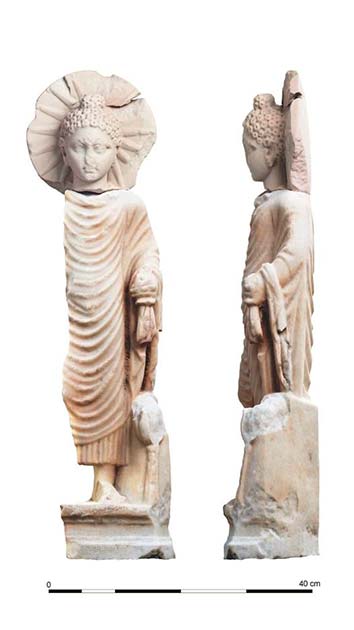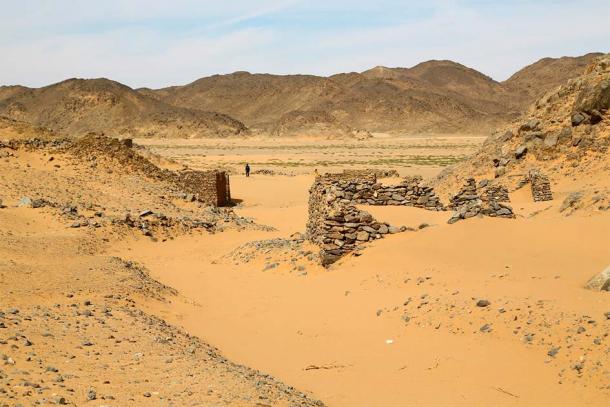
Statue Reveals Buddhists Likely Mingled with Roman’s In Egypt
Ancient history is replete with examples of cross-cultural ties that have transcended all kinds of boundaries, even before telecommunications and travel existed the way we know today. A reminder of this has been found in the ancient Egyptian port city of Berenike, on the Red Sea. A 1,900-year-old statue of Prince Siddhartha or Gautama Buddha. This discovery sheds further light on the trade ties between Roman Egypt and the subcontinent of India.
The Buddha: Statue and Princely Origins
A Polish-US mission discovered the statue "dating back to the Roman era while digging at the ancient temple in Berenike", according to a press statement by the Ministry of Tourism and Antiquities. The statue, made of Mediterranean marble and standing 2 feet (61 cm) tall is the first of its kind to be found west of Afghanistan. Two second-century coins from the central Indian kingdom of Satavahanas were also found.
- Ancient Red Sea Port May Have World’s Oldest Pet Cemetery
- Pet Monkeys Buried Like Children In Ancient Egypt
The statue's discovery is of great importance. Based on stylistic details, researchers believe it was made in Alexandria around the second century AD. A prominent feature of the statue is the halo around its head, which is covered with rays of sun, indicating the Buddha's radiant mind. The Buddha is shown standing and holding parts of his robe in his left hand. There is also a lotus flower adjacent to him.

Front and side view of the 2-foot tall Buddha sculpture. (Ministry of Tourism & Antiquities)
The Buddha or Siddhartha Gautama, lived in South Asia around 2,550 years ago. He was born a prince, who would later renounce his wealth and material possessions, and seek enlightenment. Thus, he became the Buddha, a Sanskrit-derived word that implies ‘the enlightened one’ in Buddhist tradition. The religion founded by him, Buddhism, was based on these tenets.
The Berenike (also spelled Berenice) excavations have been a joint effort between American and Polish researchers, with Steven Sidebotham, a historian at the University of Delaware, leading the American team and Mariusz Gwiazda, an archaeologist at the University of Warsaw, heading the Polish team. Sidebotham has been working at the site since excavations began in 1994, reports Live Science.
- Ancient pet cemetery and ship hull uncovered at Red Sea port
- Asian and Nubian Influences Found In Ptolemaic Era Statues in Berenice
Berenike: Central Trading Route of the Roman Empire
Berenike was founded in the third century BC and eventually became one of the largest ports in Roman-controlled Egypt. The antiquities ministry reveals that goods such as ivory, textiles, and semi-precious metals passed through the city for many years, providing a commercial link between the Roman Empire and India.

Ruins in the antique port of Berenike. (lkpro/Adobe Stock)
“Berenike is today a bleak and desolate spot. Under pale blue skies, the flat, treeless red-dust wadis of the western desert give way to the windy shores of the Red Sea… though the site contains the ruins of some once-impressive structures—a temple of Serapis, a Roman aromatics distillery, and a fine bathhouse - the walls now barely rise above knee-high. Nevertheless, these unprepossessing ruins, easily missed as you drive up the coast, were the landing point for generations of Indian merchants traveling to the Roman Empire…”, writes famed historian William Dalrymple for the NY Review.
In recent years, the Berenike excavations have unearthed other artifacts that attest to the city's cultural blending, including an inscription in Sanskrit dating to the reign of the emperor Marcus Julius Philippus, known as Phillip the Arab (reigned from 244-249). The fact that the inscription was found in Egypt is yet another piece of evidence that shows how interconnected the Roman Empire was with its ancient Indian counterpart.
Another fascinating discovery was made in 1999 when archaeologists uncovered a jar filled with 17 pounds of black peppercorns embedded in the courtyard floor of a Berenike temple. At that time, peppercorns were only grown in southwestern India, highlighting how Berenike acted as a crucial hub in the ancient trade network.
“You hear a lot about globalization today, but there was a ‘global economy’ linking Europe, Africa and Asia during the first century of the Christian era, and the city of Berenike is a perfect example of that,” concluded Sidebotham.
Top image: Detail of the 1,900-year-old statue of the Buddha found at Berenike, an ancient port city in Egypt by the Red Sea. Source: Ministry of Tourism & Antiquities
By Sahir Pandey
References
Aton, F. 2023. Buddha Statue Uncovered in an Egyptian Port City Sheds Light on Trade Between Ancient Rome and India. Available at: https://www.artnews.com/art-news/news/buddha-statue-uncovered-in-an-egyptian-port-city-sheds-light-on-trade-between-ancient-rome-and-india-1234666283/.
Jarus, O. 2023. 1st-century Buddha statue from ancient Egypt indicates Buddhists lived there in Roman times. Available at: https://www.livescience.com/archaeology/ancient-egyptians/1st-century-buddha-statue-from-ancient-egypt-indicates-buddhists-lived-there-in-roman-times.
Parker, C. 2023. Archaeologists Unearth Buddha Statue in Ancient Egyptian Port City. Available at: https://www.smithsonianmag.com/smart-news/buddha-statue-found-berenike-egypt-180982075/.
















Comments
Nowadays, Buddhists mingle with neo-Babylonians, so not much has really changed.